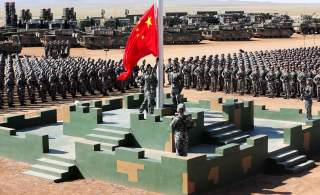China vs. Japan: Asia's Other Great Game
Beijing and Tokyo will undoubtedly compete long after U.S. foreign policy has evolved.
But current perception and likability benefit Japan only so much. When Genron NPO, the Japanese polling company, asked in 2016 if Japan would increase its influence in Asia by 2026, only 11.6 percent of Chinese and 23 percent of South Koreans answered in the affirmative; perhaps surprisingly, only 28.5 percent of Japanese themselves thought so. When Genron asked the same question about China in 2015, fully 82.5 percent of Chinese, 80 percent of South Koreans and 60 percent of Japanese expected China’s influence in Asia to increase by 2025. Two decades of Chinese economic growth and Japanese economic stagnation undoubtedly are the causes of such findings, but China’s recent political overtures under Xi Jinping likely play some role.
Despite scoring lower than Japan in regional opinion polls, China has ridden a wave of anticipation that its ultimate strength will make it the most dominant nation in Asia, if not the world. This has made it easier to attract cooperation or wary neutrality from Asian nations. The AIIB is just one example of Asian nations flocking to a Chinese proposal; the BRI is another. Beijing has used its influence in negative ways, as well, for example by pressuring Southeast Asian nations such as Cambodia or Laos to oppose stronger criticisms of China’s territorial claims in joint ASEAN communiqués.
At times, China’s very dominance has worked against it, and Japan has taken advantage of the region’s unease at China’s power. When ASEAN nations proposed what would become the East Asia Summit in the early 2000s, with the participation of China, Japan and South Korea, Tokyo successfully lobbied with Singapore for Australia, India and New Zealand to be included as full members. This inclusion of an additional three democratic nations was designed to blunt China’s influence over what was expected to become the largest pan-Asian multilateral initiative, and was decried by Chinese media for doing so.
Neither Japan nor China has succeeded in establishing a dominant position as the undisputed great power of Asia. Southeast Asian nations above all want to avoid being drawn into a Sino-Japanese—or, much the same thing, Sino-U.S./Japan—political and security dispute. The scholars Bhubhindar Singh, Sarah Teo and Benjamin Ho have argued that, in recent years, ASEAN nations have focused more on the U.S.-China relationship, since it is the United States that has Southeast Asian allies and has inserted itself into the South China Seas dispute. Yet all also consider Sino-Japanese ties to be of critical importance for Asian stability in the short and long term. While this particular concern is largely centered on security issues, and less on the larger questions of national models, when attention has turned to national development, the focus on China and Japan becomes even clearer. None dismiss the continuing importance of the United States to Asia’s short- and medium-term future, but awareness of the long history of Sino-Japanese relations and competition is a primary element of the larger regional perception of power, leadership and threat that will shape Asia in the coming decades.
It is a truism, though not unhelpful, to observe that neither Japan nor China can leave Asia. They are stuck with each other and with their neighbors, and each has an intense relationship with the United States. Japan and China’s economic ties are likely to deepen in future years, even as both look for alternative opportunities as well as seek to structure Asian trade and economic relations in ways most beneficial to their own interests. There will undoubtedly be periods of greater political cooperation between Beijing and Tokyo, along with the minimal quotidian diplomatic niceties. There will continue to be grassroots exchange—at the very least, unorganized exchange through millions of tourists.
Their histories and civilizational achievements, however, all but assure that they will remain the two most powerful Asian nations, and that implies an ongoing competition. Whether Japan remains allied to the United States or not, or whether China successfully forges a pan-Asian Belt and Road community, the two will continue to try to shape the Asian political, economic and security environment. With a United States that continues to be challenged by its global commitments and interests, thereby leading to periods of relative lassitude in Asia, China and Japan will stay bound in a complex, often tense and competitive relationship that is Asia’s eternal great game.
Michael Auslin is the Williams-Griffis Fellow in Contemporary Asia at the Hoover Institution, Stanford University. This essay was written while he was a resident scholar at the American Enterprise Institute.

